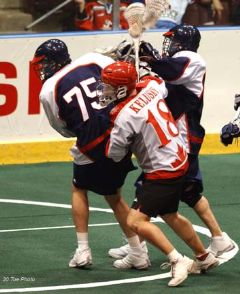Some of the findings my surprise many players, clinicians & parents, including the fact that protective equipment, such as helmets or mouth guards, appear to do little to prevent concussion & in fact by encouraging players to feel more confident, may actually increase risk of concussion. Whilst helmets are recognised as providing protection against lacerations & fractures, the mechanism of a concussive injury, whereby the soft brain collides with the hard skull, is unaffected by wearing a helmet as the decelerative forces are not altered.
The panel discussed the current evidence & best practice, to evaluate the approaches to prevention, assessment, management & recovery of concussive injury sustained in the sporting environment. In addition, the panel deemed it necessary to initially decide on the definition of the term "concussion".
The Consensus subsequently defines "concussion" as "a brain injury" & "a complex pathophysiological process affecting the brain, induced by biomechanical forces". The panel further identified a number of common features that incorporate the clinical, pathologic & biomechanical injury constructs that may be considered in defining the nature of a concussive head injury. These include:
1. "Concussion may be caused either by a direct blow to the head, face, neck or elsewhere on the body with an ‘‘impulsive’ force transmitted to the head.
2. Concussion typically results in the rapid onset of short-lived impairment of neurological function that resolves spontaneously. However, in some cases, symptoms & signs may evolve over a number of minutes to hours.
3. Concussion may result in neuropathological changes, but the acute clinical symptoms largely reflect a functional disturbance rather than a structural injury &, as such, no abnormality is seen on standard structural neuroimaging studies.
4. Concussion results in a graded set of clinical symptoms that may or may not involve loss of consciousness. Resolution of the clinical & cognitive symptoms typically follows a sequential course. However, it is important to note that in some cases symptoms may be prolonged."
The Consensus describes the suspected diagnosis of a concussive injury as including one or more of the following clinical findings:
1. "Symptoms - somatic (eg, headache), cognitive (eg, feeling like in a fog) &/or emotional symptoms (eg, lability);
2. Physical signs (eg, loss of consciousness (LOC), amnesia);
3. Behavioural changes (eg, irritability);
4. Cognitive impairment (eg, slowed reaction times);
5. Sleep disturbance (eg, insomnia)."
Should any of the above findings be present, a full assessment process should be undertaken, which can be tailored to suit the environment, whether it is pitch-side or in a controlled clinical environment.
The initial assessments should include the primary first aid checks, a SCAT 3 evaluation (or other primary sideline assessment tool), followed by ongoing observations for symptom detection.
Secondary assessments should include comprehensive medical, neurological & neuropsychological examinations, a determination of the patient's clinical status & a determination of the imaging investigations required.
Concussion management should initially consist of physical & cognitive rest (24-48 hours), before the patient embarks on a graduated & criteria-driven return to play protocol. For those that display a slow rate of recovery, it has been suggested that low-level exercise may be of more benefit than prolonged rest. However, the panel were adamant that no matter how complete & quick the recovery appears, no return to play should occur on the same day as the concussive injury is sustained.
| REHABILITATION STAGE | FUNCTIONAL EXERCISE AT EACH REHAB STAGE | OBJECTIVE OF EACH STAGE |
| 1. No activity | Symptom limited physical & cognitive rest | Recovery |
| 2. Light aerobic exercise | Walking, swimming or stationary cycling keeping intensity <70% maximum permitted heart rate. No resistance training. | Increase HR |
| 3. Sport-specific exercise | Skating drills in ice hockey, running drills in soccer. No head impact activities. | Add movement |
| 4. Non-contact training drills | Progression to more complex training drills, eg, passing drills in football & ice hockey. May start progressive resistance training. | Exercise, coordination & cognitive load |
| 5. Full-contact practice | Following medical clearance participate in normal training activities. | Restore confidence & assess functional skills by coaching staff |
| 6. Return to play | Normal game play |
It was acknowledged that various factors may contribute to a modified management of a concussive injury, including number, nature, severity & duration of signs & symptoms, gender, age, sport, premorbidity or comorbidity, medication & sporting behaviour.
Other considerations in relation to information dissemination, medico-legal aspects, future research requirements & advances in clinical practice were also discussed.
Overall, the Consensus is a fantastic summary of the most current knowledge in sports concussion & is a must-read for any medical professional working in front-line sport.
To review the paper as a whole, please click on the link below:

